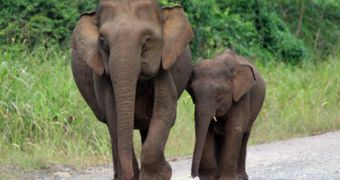Here is a dwarf amongst living elephants: the pygmy elephant of Borneo is one meter (3 feet) shorter than its mainland Asian elephant counterparts and remarkably tame and passive. They also look different from other Asian elephants, being rounder and with longer Tails, straighter tusks, a shorter trunk and bigger ears.
A new study published in the Sarawak Museum Journal seems to have explained its mystery: this elephant represents an inadvertently saved population of extinct pygmy elephants from Java, another Indonesian island.
Today, these elephants can be found only in the northeastern part of Borneo Island, mainly in the Malaysian state of Sabah, but also in the neighboring areas of Brunei and Indonesia. The elephants' small range and tameness have always represented a puzzle.
The new results researchers came up with combined archaeological and historical data. Local belief claims the elephants came into Borneo from the island of Sulu (now in the Philippines). The sultan of Java seems to have offered the Javan elephants as a gift to the sultan of Sulu. Nobody knows why, but descendants of the elephants were later abandoned in Borneo. The original Javan population disappeared by the end of the 18th century.
"These elephants may be the oldest example of a wild [mammal] population that is saved without intention to do so by royalty and through a captive detour," said Michael Stuewe, an elephant biologist for WWF, an international conservation organization. In 2003, Stuewe's team revealed that the Bornean elephants were genetically very distinct from other populations of Asian elephants.
It has been thought that the elephants had been isolated on Borneo when the last land bridges connecting it to the mainland were flooded by the sea about 18,000 years ago. However, the authors of the new study could not detect archaeological or historical proofs of the existence of elephants on Borneo beyond several centuries. It seems logical that the Bornean elephant population "consists of remnant survivors of the extinct Javan population. The study raises the importance of the Bornean population and suggests other large mammals could be saved from extinction by removal from threatened habitat to safer locations," wrote the authors.
"The population will likely be given less of a conservation priority, since it is outside its original wild range. [Such] factors are generally seen as downgrading the importance of such populations versus the truly wild animals," said Simon Hedges, the Asian elephant coordinator for the New York-based Wildlife Conservation Society.
Other cases of royalty inadvertently saving a mammal from extinction have been known to occur. The last individuals of alpine ibex were saved by an Italian king in the 1850s, captive-bred by the Swiss, and have been reintroduced throughout the Alps now. The European bison was saved from extinction by the Polish kings in the forest of Bialoweja.
Przewalski horses were imported from Mongolia in the early 20th century by European monarchs for their stables. The wild horses disappeared in the 1960s, but individuals coming now from Europe have been set to roam free in Mongolia starting with 1992.
"The ability of these large charismatic mammals to recover from what seem to be extreme [population] bottlenecks apparently is there. Today, the elephants face new challenges from the rapidly developing palm oil industry in northeastern Borneo, where the remnant population is located," Stuewe said.
Menaces to the last Bornean elephants
These gentle creatures are now menaced by the shrinking and fragmentation of their habitat, the forests.
"Driven by surging demand from the biofuels industry, the forest is being converted to palm oil plantations at increasing rates. And unfortunately, oil palm plantations are to elephants what a candy store is to little kids - they just love them," said Stuewe.
This brings them in conflict with humans, who regard the elephants as a pest and kill them. A 2007 survey estimated that a little over 1,000 individuals of Borneo elephants are left alive at the moment.
"The only hope for these elephants now is protection of the lowland forest as nature reserves or sustainably managed logging concessions," said Stuewe. "The palm oil expansion threatens a host of species on Borneo. One ultimately hopes that some of the expansions of the oil palm industry are going to be controlled and done in an appropriate way so that the whole suite of species at risk isn't wiped out," Hedges added.
Satellite tracking revealed that the remaining herds of Borneo elephants prefer jungles on flat lowlands and in river valleys, the same areas preferred by loggers and for oil palm plantations. Human activity pushed elephants to unsuitable swamp areas and restricted their ranges to narrow corridors. About 40% of forest cover in Sabah has been lost to logging, plantations and human settlement over the last four decades.
Some of the elephants forage five times more than normally due to the human impact. A herd of up to 45 elephants normally moved up to 1.2 miles (2 km) a day, but now they are forced to move 3.9 miles (6.4 km) daily. These elephants can ingest up to 150 kilograms (330 pounds) of vegetation daily, from palms to grasses and wild bananas. One of their delicacies is the large thorny durian fruit, that has what has been called the worst smell in the world. These elephants often roll the entire fruit in mud so they can swallow it, spikes and all. The seeds pass unaffected through the elephant's gut and the animal further disperses the remains of the tree. It is one of the elephant's ecological roles.

 14 DAY TRIAL //
14 DAY TRIAL //